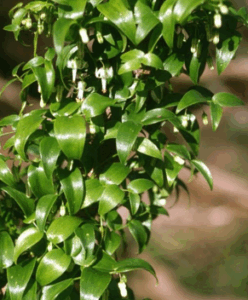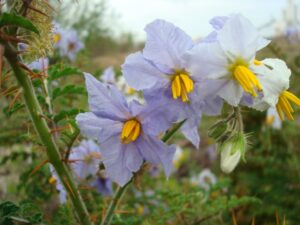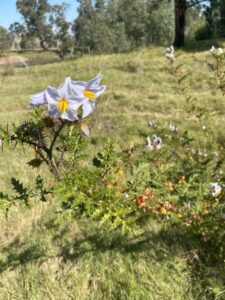WEEDS MANAGEMENT
WEED ALERT
Wheel cactus (Opuntia robusta)
An invasive cacti species growing up to 1-2m tall – sometimes up to 4m in some specimens. Adaptable, it grows in arid, warm temperate and subtropical climates but it can tolerate cooler temperate areas. Plants can survive extremely high temperatures up to 50 °C and low temperatures down to -7°C. Very drought tolerant.
Unmanaged the wheel cactus forms dense thickets and reduces biodiversity. The sharp spines:
– Cause painful injuries to people, livestock and companion animals.
– Impede human/livestock movement within infestation zones.
– Devalue wool/hide values and increase the risk of injury when handling livestock.
– Also harbors other invasive species such as foxes and rabbits.
The species produces viable seed in fruiting bodies which are often spread by birds. New plants also arise from fallen plant parts (vegetative spread). Deliberate introduction to new areas by people (ornamental gardeners) is another major cause of spread.
To learn more visit the CGRC website and visit NSW Weed Wise https://weeds.dpi.nsw.gov.au/Weeds/WheelCactus Download the free App.
If you believe you have seen this plant please contact CGRC Biosecurity Officers on 1300 459 689
Wheel Cactus Information Package
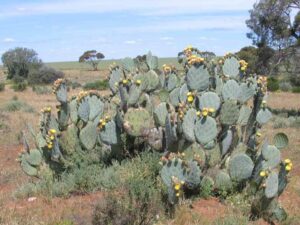
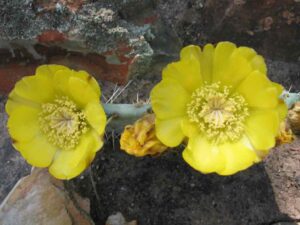
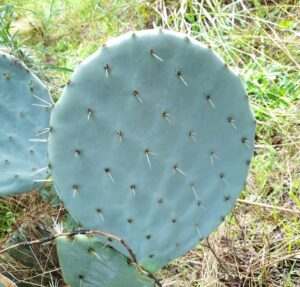
BRIDAL CREEPER
Bridal creeper is a climbing perennial plant that grows during autumn and winter. It is a smothering vine that outcompetes native vegetation and reduces biodiversity in bushland. Similarly, it is often a nuisance plant in ornamental gardens due to its dense growth habit and ability to outcompete desirable ornamentals. Bridal creeper produces berries that are consumed by birds which then spread viable seed. The root system is extensive and contains rhizomatous tubers which are capable of forming new plants in contaminated/disturbed soil. Bridal creeper is currently entering its active growth season and is scheduled with a general biosecurity requiring landholders to prevent, eliminate or minimise the species. Bridal creeper must not be imported into the state, sold, bartered, exchanged or offered for sale in NSW.
For further information and assistance with identification, biosecurity duty and control methods visit and download the free NSW Weed wise app. NSW WeedWise
Bridal Creeper Information Package
MESQUITE
Mesquite (Prosopis spp.) is an invasive perennial shrub or tree that outcompetes native vegetation and improved pastures by forming impenetrable thickets. The species is characterised by large spines that cause injury to livestock, people and damage machinery. The species is adaptable and grows in a wide range of soil types. It is scheduled with an eradication management goal in the Riverina. If you believe you have observed this plant please call Cootamundra-Gundagai Regional Council 1300 459 689. Follow the link for further information and assistance in plant identification. https://weeds.dpi.nsw.gov.au/Weeds/Mesquite
Visit NSW Weed Wise and download the free app for information on weed species and required management (Biosecurity duty).
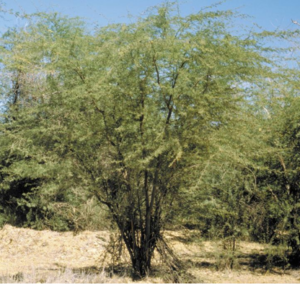
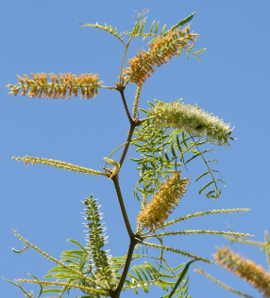
WATER POPPY
Many landholders associate priority weed species with larger scale farmland or roadsides. However, priority weed species with the potential for major negative impacts on the environment can exist in peoples backyards. One such species is Water poppy (Hydrocleys nymphoides).
Water poppy is an invasive aquatic species that forms dense entangled mats in waterways that obstructs water flow and increases flood risks. The dense growth habit also reduces light availability and oxygen levels in water bodies – reducing overall biodiversity. Water accessibility for recreational purposes is reduced and damage to irrigation equipment can occur in infested waterways. The species proliferates as it has the ability to form new roots from nodes in the stems. Breakage or dislodgement of stems allows the plant to float along waterways and form new incursions once it has anchored in a suitable locality. The plant was introduced as an ornamental species and so human movement of plants (whether intentional or not) also facilitates spread. Private gardens and farm dams are often primary infestation zones in new areas where plant material is disposed of irresponsibly or overflow of ponds/dams allows introduction into natural waterways.
For further information please follow the link for species characteristics and phtos to assist identification. Visit NSW Weed Wise https://weeds.dpi.nsw.gov.au/Weeds/WaterPoppy If you believe you have observed this plant please contact CGRC on 1300 459 689
Water poppy Information Package (002)
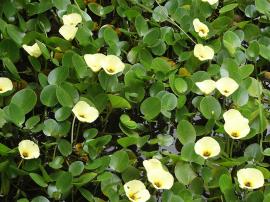
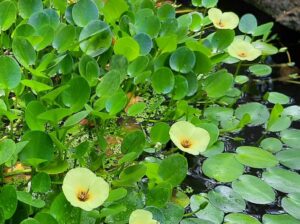
STICKY NIGHTSHADE
Sticky Nightshade is an invasive species with an eradication management goal within the LGA. The plant grows up to 1.5m high with leaves, leaf stalks and main growing stems covered in yellow/red prickles. Plants have been identified in neighbouring council areas. More recently, CGRC biosecurity officers have detected and controlled plants on the Nangus Rd and the Burley Griffin Way. This plant is not to be confused with native/common Narrawa burr. Please follow the link for further information on species characteristics and photos to aid identification. Visit NSW WeedWise https://weeds.dpi.nsw.gov.au/Weeds/Stickynightshade
Sticky Nightshade Information Package
ILLEGAL DUMPING PLANTS INFORMATION PACKAGE
The NSW Biosecurity Act stipulates that any person who deals with biosecurity matter is required to exercise their general biosecurity duty (Visit View – NSW legislation for further information). Many ornamental plant species are capable of establishing themselves and proliferating roadside with several species observed (sporadically) along CGRC roads. Illegal dumping of unwanted plant material or failure to contain plants within property boundaries are avenues for these plants to encroach bushland and (in some cases) out compete remnant native species. Follow the link for examples of some common ornamental species to be mindful of and methods to reduce any biosecurity risks.
Illegal dumping plants Information Package
WEED ALERT
ALLIGATOR WEED
Alligator weed is an aquatic weed species not yet known to occur in the CGRC local council area and scheduled for Prevention/Eradication managerial goals. This species has significant deleterious effects on waterways and riparian zones due to its aggressive growth habit which increases sedimentation and severity of flooding events. Negative impacts on industry reliant on irrigation and/or recreational water usage occur due to the species impacting water accessibility and altering the environment. The Murrumbidgee is considered a high risk pathway for Alligator weed entry and establishment in CGRC waterways. If you believe you have observed this species please call Cootamundra-Gundagai Biosecurity Officers on 1300 459 689. Follow the link for more information on Alligator weed, visit NSW WeedWise and download the free app https://weeds.dpi.nsw.gov.au/
Alligator Weed Information Package
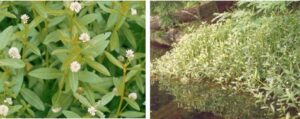
CHILEAN NEEDLE GRASS
Chilean needle grass is an invasive perennial (tussock forming) grass growing up to 1m high. It is tolerant of a range of soil types and capable of invading even undisturbed natural ecosystems. The species can outcompete native vegetation and is of low digestibility and nutritional value to grazing livestock. The characteristic “spear” seed heads are adept at penetrating the skin – decreasing the welfare, carcass and skin values of livestock. This species is scheduled with an eradication managerial goal within the CGRC area. If you believe you have seen this species please contact CGRC Biosecurity Officers for assistance in identification and control options. Follow the link for further information on Chilean needle grass or visit NSW Weed Wise https://weeds.dpi.nsw.gov.au/ and download the free App.
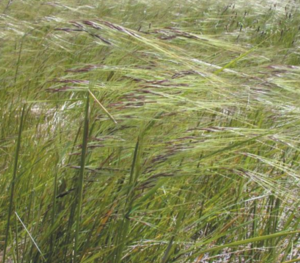
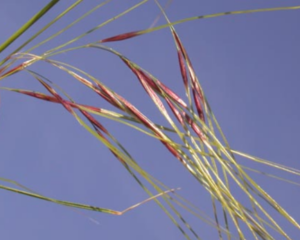
COOLATAI GRASS
Coolatai grass is a predominantly Summer active species that occurs along several roadsides within CGRC. The species proliferates by means of seed dispersal and due to its perennial lifecycle has the potential to dominate land used for intensive farming purposes as well as non-agriculture/conservation areas.
Please follow the link for more information, visit NSW Weedwise https://weeds.dpi.nsw.gov.au/ or download the free app.
If you believe you have seen this species please contact one of Councils’ Biosecurity Officers on 1300 459 689.


MEXICAN FEATHER GRASS
Mexican feather grass is scheduled prohibited matter in the state of NSW – the species should not be sold anywhere. The species is a prolific seeder with each plant capable of producing up to 100 000 seeds annually. Additionally, it is a resilient tussock type grass that is capable of establishing and spreading in many different climates and soil types (approximately 65% of NSW suitable of Mexican feather grass). All known incursions of Mexican feather grass in NSW have been eradicated or are currently under and eradication program.
The highest risk for Mexican feather grass introduction into the Riverina is via private gardens/ornamental plant trade. Mislabeled plants lead to inadvertent introduction into land areas free of the species where seeds are then spread by wind, water run-off and attaching to clothing or animals. The species has been found for sale in nurseries under the following incorrect names:
- Elegant spear grass (Austrostipa elegantissima)
- Stipa lessingiana
- Stipa capillata
- Stipa capriccio
- Stipa Regal Sensation.
Online seed companies have also sold the species under various names:
- Stipa tenuissima
- Stipa tenaccissima
- Elegant spear grass
- White tussock
- Texas tussock grass
- Ponytail grass.
Thorough research of plants before introducing them to the home garden is always recommended to avoid potential establishment of scheduled priority weeds. For more information on this species follow the link the CGRC information package and visit NSW WeedWise https://weeds.dpi.nsw.gov.au/Weeds/MexicanFeatherGrass and download the free application.
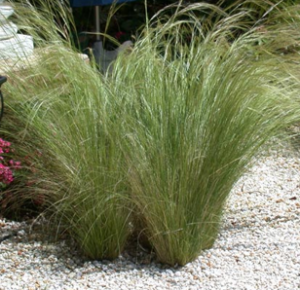
Mexican feather-grass Information Package
MOTHER OF MILLIONS
Mother of millions Information Package
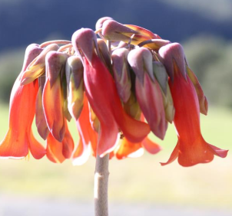
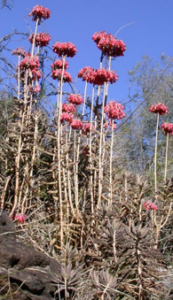
Coolatai Grass
Coolatai grass is a predominantly Summer active species that occurs along several roadsides within CGRC. The species proliferates by means of seed dispersal and due to its perennial lifecycle has the potential to dominate land used for intensive farming purposes as well as non-agriculture/conservation areas. Please follow the link for more information, visit NSW Weedwise or download the free app. If you believe you have seen this species please contact one of Councils’ Biosecurity Officers on 1300 459 689.
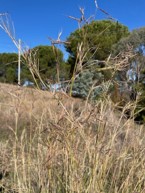
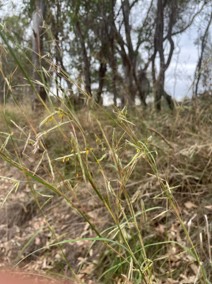
Serrated Tussock:
With many Summer weeds entering dormancy coming into the Winter period; there are still weeds that are able to be dealt with due to their perennial growth habit. Serrated tussock is one such species that has been identified on several properties in the CGRC area. This weed can be difficult to identify in the environment and is scheduled for eradication – for further information follow the link.
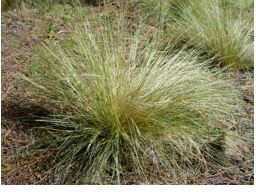
Serrated Tussock Information Package
Foxtail Fern: Have you seen this plant? Foxtail Fern exists in many gardens but did you know it is a scheduled weed species? Read below to learn your roles and responsibilities when dealing with this plant.
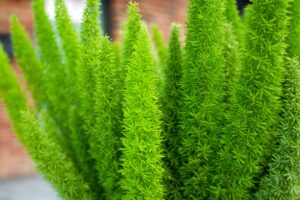
Sticky Nightshade is a developing problem in the Riverina with populations identified in neighboring Council areas. Isolated plants have been found and destroyed on the Burley Griffin roadside this past Summer – this plant is now scheduled as a priority weed for eradication within the region. If you believe you have seen this plant on your property please contact Cootamundra-Gundagai Biosecurity weeds officers on 1300 459 689.
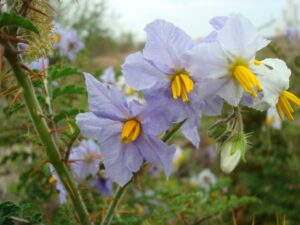
WEED SPRAYING NOTIFICATION:
Council wishes to advise residents across the region that weed spraying will be undertaken. Notification is done in accordance with the Pesticide Regulation 1995. Herbicide application will occur during the months of January 2024 to December 2024 in the town and village streets and lanes, for the eradication of weeds in the road and culverts, as well as weed control in public spaces.
One of the main objective of the Biosecurity Act 2015 is to prevent the spread of noxious weeds.
Cootamundra-Gundagai Regional Council (CGRC) employees two Weeds Inspectors to manage and control Council’s weeds operations and to establish strategies and statements to control weeds in accordance with the Biosecurity Act 2015 within the Council region. Our Officers carry out inspections on private property and works with Local LLS and Council to ensure weeds are managed throughout the Council area.
Weed Spraying in townships is advertised in CGRC fortnightly newsletter, snippets, Facebook, and via Council website. Roadside weeds spraying is carried out by Council insectors periodically throughout the year.
Weed management is an integral part of sustainable agriculture, sound environmental management and the maintenance of biosecurity that underpins our rural industries. Cootamundra-Gundagai Regional Council (CGRC), undertakes a strict weed management regime, to ensure the region is protected from the negative impact of weeds and thereby strengthening the sustainability of the natural environment, primary industries and local communities in the region.
Council is required under the Biosecurity Act 2015 to control and eradicate noxious weeds on Council owned land (roadside spray included). Privately owned land including landowners and lessees and Crown land on behalf of the State Government. Across the CGRC region weed control is carried out for a number of reasons. Weeds of varying varieties have the ability to crowd out or restrict light to more desirable plants, draw nutrients from the soil, encourage pests and diseases that can degrade crop and stock quality. Some weeds can severely damage paths and walkways which could become hazardous to those walking on them and, if left unchecked, are very expensive to repair. Weed control is the botanical component of pest control, which attempts to stop weeds, especially noxious or injurious weeds, from competing with desired flora and fauna, this includes domesticated plants and livestock, and in natural settings, it includes stopping non local species competing with native, local, species, especially so in reserves and heritage areas.
CGRC Weed Spraying Officers will be conducting Weed Spraying across the region During 2024. This spraying program will be in Cootamundra, Gundagai and all villages and will encompass streets, laneways, road sides, culverts and various other public spaces across the region.
Pesticide Use Notification Plan | NSW Environment and Heritage
CGRC Pesticide Notification Plan
Emergency Pesticides Use
Emergency applications of pesticides in public areas for problems of dangerous insect’s that pose an immediate danger of public health and safety, Council will, where possible, post signs in the vicinity of the application.
In the event of pesticide application in an emergency situation in a sensitive area to control a dangerous pest infestation, the Council will organize a door-knock (in a reasonable amount of time) prior to the application of pesticide. (see notification plan for sensitive areas in pesticide notification plan).
Get the free weeds app
HELPFUL LINKS AND DOCUMENTS
Riverina Regional Strategic Weed Management Plan 2017-2022 -Riverina Local Land Services
Weed-control-for-winter-crops-2020
https://www.dpi.nsw.gov.au/about-us/legislation/list/biosecurity-act-2015
Please contact the Council on 1300 459 689 for any enquiries and you will be put in contact with one of our Weeds Inspectors.

